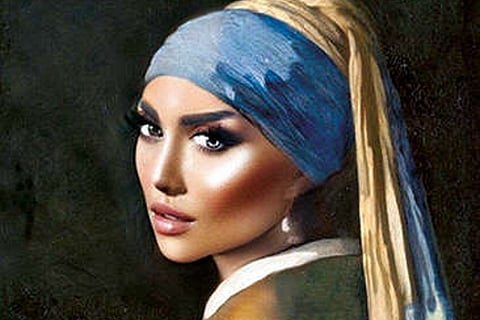

Chennai
These are just a few of the altered images that have been shared by YassifyBot, a Twitter account that started popping up in people’s feeds this month. To “yassify” something, in the account’s parlance, is to apply several beauty filters to a picture using FaceApp, an AI photo-editing application, until its subject — be that a celebrity, a historical figure, a fictional character or a work of fine art — becomes almost unrecognisably made up.
Since YassifyBot’s account was activated on Nov 13, it has tweeted hundreds of photographs in which subjects’ lashes appear thick and spidery; their eyebrows look as though they’ve seen the business end of a pencil; their hair has been lengthened and, often, coloured; and their cheekbones and nose are sharply contoured.
It should be noted that YassifyBot is not actually a bot. Its tweets aren’t generated by software. The account is run by a 22-year-old college student in Omaha who makes art under the name Denver Adams. The process for making each image is simple: Take a face, run it through FaceApp until it looks generically or grotesquely sexy, post, repeat. Each image takes only a few minutes to create.
The timing of the account’s popularity is a bit puzzling. Easy-to-use photo-retouching apps aren’t new. FaceApp specifically has been the subject of news articles about privacy issues and its “hot” filter, which was decried as racist for lightening users’ skin tones. The word “yass” — which can also be spelled “yas,” “yaas” or with any number of A’s and S’s for emphasis — has been circulating in LGBTQ vernacular for more than a decade. The word was further popularised by a 2013 video of a fan admiring Lady Gaga. The Comedy Central show “Broad City,” in which Ilana Glazer’s character frequently deploys the phrase “yas queen,” also helped to bring the word into wider use.
According to KnowYourMeme.com, the word “yassification” first appeared on Twitter in 2020. As it spread, so did memes of celebrities being digitally made over. But what, exactly, is the joke? Adams chalks it up to the sheer ridiculousness of the images, saying that the more absurd they appear, the funnier they become. Like many internet jokes, the line between mocking and celebration is murky. Rusty Barrett, a professor of linguistics at the University of Kentucky who has researched language in gay subcultures, sees a link between the images disseminated by YassifyBot and the culture of drag.
“It evokes drag in that drag queens sometimes look plastic and way overdone,” Prof. Barrett said in a phone interview. “Part of it is that it looks good, but it clearly looks fake,” Prof. Barrett said. “That positive view of artifice is something that is common across gay culture.” The “yassify” memes also share some DNA with the internet subculture of “bimbofication,” which valourises a vapid and surgically enhanced brand of femininity. Most bimbofication memes are just internet jokes about gender performativity, but some hard-core devotees have taken to Reddit to document their real-life transformations, including self-hypnosis to become more “smooth-brained.” All memes have a shelf life, and yassification fatigue has already set in. On the day the YassifyBot joined Twitter, one user tweeted: “I saw the best minds of my generation destroyed by yassification.” “If I wasn’t the one running the account, I would have already blocked the account,” Adams said. “Fully.”
O’Neill is a journalist with NYT©2021
The New York Times
Visit news.dtnext.in to explore our interactive epaper!
Download the DT Next app for more exciting features!
Click here for iOS
Click here for Android